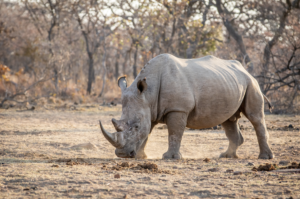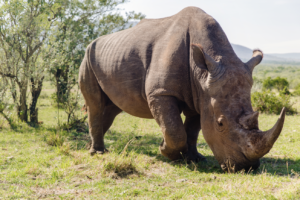An Iconic Animal on the brink
The rhinoceros is a uniquely beautiful animal to be in the presence of. Its massive size and strength are of Jurassic proportions is a sight to behold. However, the time to witness one of these animals in the wild is ticking away as rhinos are being poached to extinction. At the beginning of the 20th century, an estimated 500,000 were roaming in Africa and Asia. Today, only an estimated 27,431 remain in the wild, based on the most recent data.

Due to the false belief that their horns have magical medicinal powers, a rhino horn is an extremely valuable item. However, the truth is that rhino horns are no more than the same material as your hair or nails. You might as well bite your nails and you’ll get the same effect, which is none. Priced more valuable than gold on the black market, one kilogram can cost around $65,000 in Asia. This figure leads people to enroll in the dangerous and illegal grotesque practice of poaching.
The war against rhino poaching to protect this incredible species is not an easy one. Nor is it simple. One of the main aspected is designating protected land for the animals to roam, as well as armed and trained soldiers to ward off any poachers. Policies must also be put into place to enforce protections. In addition to this, there has to be community education, and an effort to create financially supportive job opportunities so people will not turn to poaching in the first place. Above all, there has to be funding to make any of this possible.
Losing the war
Right now, we are losing the war against the poaching of this iconic animal. The southern White Rhino was once considered extinct in Uganda. It will take governments around the world to tackle wildlife trafficking and corruption at the highest level. Otherwise, the relentless slaughter will continue until the last rhino in the wild becomes extinct during our lifetime. However, grassroots efforts to support their protection and reintroduction of this incredible species can make an immense impact on the survival of this beautiful species.

SAFE Worldwide’s own projects
SAFE Worldwide is proud to be part of the “Return of the Rhino” project in Uganda as we work to return this iconic animal back to the land where it belongs. Reintroducing the Southern White rhino back to Uganda is a way to turn back time and to right a wrong from decades ago. This, coupled with continual protection, will tackle the population issues inflicted by poaching head-on. Rhinos have been absent for much too long, and it is with great pride that Ugandans can now say that the rhino is back in their homeland.
have also been supporting a project in Indonesia for the Javan rhino. There are only 90 of these animals left in the wild and they reside in only one national park in Indonesia, Ujung Kulon National Park. Our funds allow for processing data from video trap cameras from February until December 2021 related to the dynamics of wildlife populations including the number population, sex ratio, correlation between rhinos and other animals, and space competition of the rhino with other big mammals, such as the forest elephants and Javan leopards.
Sources cited
Scientific American. (2016, April 6). Species fate at stake as South Africa considers Rhino Horn Trade. Scientific American. Retrieved September 19, 2021, from https://www.scientificamerican.com/article/species-fate-at-stake-as-south-africa-considers-rhino-horn-trade/.
World Wildlife Fund. (n.d.). White rhino. WWF. Retrieved September 19, 2021, from https://www.worldwildlife.org/species/white-rhino.


